ASTRONOMY UNDER STAIRS
by Manuele Turini
I’m a fan of astronomy since when I was a boy, this has filled my thoughts for years, then inevitably the course of life takes you on roads very often not chosen by you, so even the passions tend to fade.
But you know the first love never forget! So it can happen that the passion seeks you.
For work I often examine many DARK images produced

by cooled digital CCD cameras, in fact, simply looking at a picture of dark you can check many conditions of operation of this kind of instrument.
So, it often happens to see the tracks left by the cosmic rays on the CCD pixels when impacting.
Not all CCD sensors behave the same way when an x-ray impacts on it: some of them are much more sensitive than others, I can’t say why but it probably depends on different dopant used in silicon.
I never managed to establish a correlation with the environment or some astronomical event, but the fact that some days the frequency of x-ray is higher than others has always intrigued me most.
Cosmic rays are energetic particles from outer space to which the Earth and all of us are exposed.
The discovery of cosmic rays is due to the Austrian Victor Franz Hess and the Italian Domenico Pacini with works published on 1912 (individual discovery but contemporary).
Before that cosmic rays interact with Earth's atmosphere, they are largely consisting of protons (95%) and helium nuclei (almost 5%); but also other light nuclei and electrons, photons, neutrinos and antimatter fraction (positrons and antiprotons) are among the primary cosmic rays.
Reached the Earth's atmosphere, these particles interact with the nuclei forming the molecules of the atmosphere, in a cascade process (see figure below), new particles projected forward, that are called secondary cosmic rays.
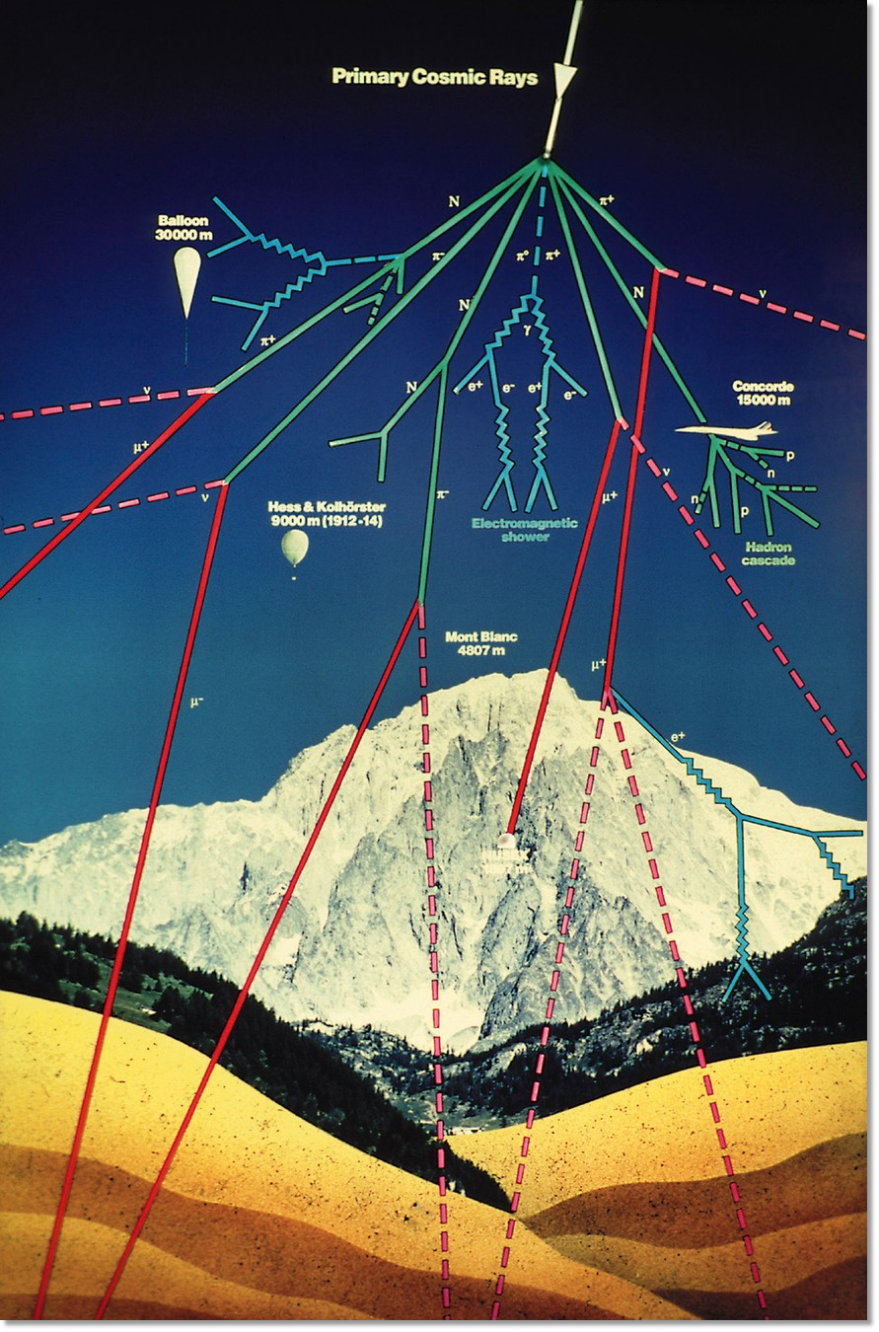
In the world there are many laboratories involved in this field, working on very different techniques for detecting them.
Since I have easy access to instruments based on CCD sensors, I have decided to use them to study cosmic x-rays.
Two years ago, I started my observations by the use of a cooled digital CCD camera equipped with a FOS and a beryllium window.
I decided to work on the following operative conditions: event recording 24 hours a day for ten days, 20s of exposition time in binning 2x2, CCD sensor temperature @ 10 °C.
To decrease the noise due to the dark current, it would have been better to work at lower sensor temperature.
But the FOS glued on the sensor involves there is a risk on going down 0 °C due to the different expansion coefficients of silicon, glue and glass of the window.
Any case, although the temperature was quite high, I had always very good signal/noise ratios.
Furthermore, I decided for a binning 2x2 so to reduce the dimension of the images without to lose on detecting area.
In fact, you have to take into account that in these conditions, you have more than 4000 images a day, for a total of 2.1 Gb/day!
Other then, you can’t overlook the time spent by the program in order to extract the events recorded by all these images and the configuration I chose is a good compromise.
The result of this campaign of observations has been very interesting, even if it has opened more questions than answers.
Well, without further preambles, here the results: the graph below shows the number of events in function of the time. The graph shows about eight hours of recording:

Perhaps because of the graphic too compressed, you have not still realized that the trend has two modulations of the flux: one fast and another much more slower than this.
And it is repeated in the following days …
I did not expect to find some sort of "information" but rather a chaotic trend. So, conscious of my ignorance on this field, I tried to ask for help to some researchers at national laboratories that deal with cosmic rays.
Here below some of their answers:
“ The flow of cosmic rays varies in anticorrelation with the daily graph of atmospheric pressure, that during 24 hours (in addition to changes in the long period due to perturbations, etc.) goes up and down in an almost sinusoidal mode and has two maxima and two minima.
If you have a barometer, you can measure the pressure and find the precise correlation between counts and pressure.
With reference to short period variations, there can be multiple causes, a problem with the instruments or something more physical ... or maybe the bus passing in the street under your home... ”
Another researcher answered me:
“ The rate of muons ranges between 100 and 200 per square metre (it dipends on altitude: higher the layer of atmosphere they pass, higher the probability to decade. In fact, muons are particles with half-life of about 2 microseconds, especially if they are low energy particles).
You can put your hand on your heart about these numbers.
If possible, try to repeat your observations increasing the event/ noise discrimination threshold: look if now the flux is uniform (here attached the distribution of cosmic ray sampling relative to your data ... in effect, you can find a 20% averaged variation on the flux).
Another try:
Ambient background signal due to something at low energy (alfa particles mainly due to presence of radon, for example ...)or activated metals, etc. etc. : the only way to eliminate this signal is to put two detectors in coincidence along the vertical axis at a fixed distance.
This way, you can detect all the passing cosmic ray (clearly at this point you would consider the angle acceptance), while the alfa rubbish will give a signal completely uncorrelated on the two detectors – change room!”
Latter researcher provided me with an elaboration of the rough data I sent him, from which one can infer the modulation of the flux:
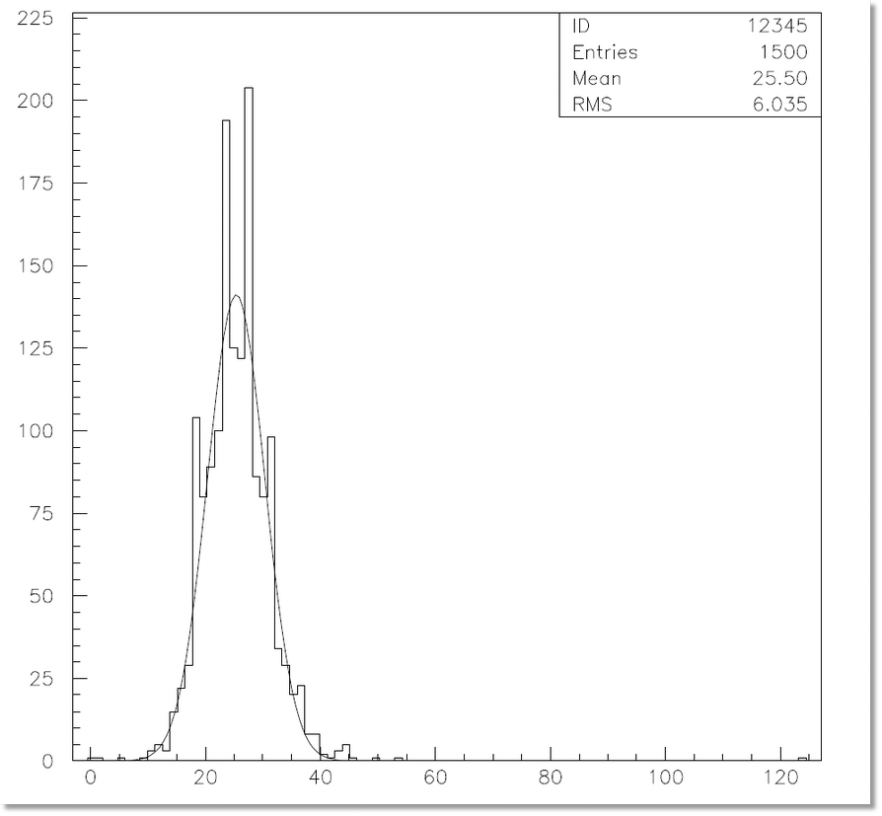
At this point, I realize I need a large amount of time to deepen the problem, so I start planning further checks and measures to be carried out.
Unfortunately two years have passed since the first observation and all is still at the starting point, maybe it is reasonable to infer that I have or I can not afford to spend some time for this survey, yet the first campaign was performed in a period of holidays.
I would have really liked to publish the result of this campaign of observations with more certainty, but at this point, I think it’s better to share with the others what I have found.
Of course, the hope is that some amateur astronomer goes on with this survey.
Ultimately, as observation activity it has several advantages: it can be practiced even under stairs 24 hours a day, also using sensors of a low grade and you can also use a normal cooled CCD even though this will have preference to interact only with high energy particles.
Here t is shown in details how the experiment has been done:

The CCD camera used for the experiment
The measures has been carried out by a 16 bit cooled digital CCD camera mounting a 1024x1024 pixel, 24 m square CCD sensor, so the image area was 24.5x24.5 mm.
A FOS (Fiber Optic Scintillator) had been glued on the CCD sensor.
This camera was born for low energy X ray applications (8-40Kev) but it has been very useful even in this application, since the silicon interacts directly with the high energy radiation, while the scintillator converts in visible rays the low energy rays, that rarely interact with the silicon of the sensor.
As you can see from the picture above, the FOS is realized using a FPO (Fiber Optic Plate), in practice a bundle of fiber optics of few microns simply carrying the light generated by the scintillator directly on the pixels of the CCD.
There are various types of scintillators on the market, the mine was made by gadolinium sulphide (Gd2O2S), an inorganic crystal capable of producing photons at 550 nm when interacting with a particle or a high energy photon with a transfer energy efficiency greater than 10%
In front of the CCD camera, there was a beryllium window, that is transparent to the particles and it cuts completely the ambient light.
In place of the dangerous beryllium (a carginogen element), you can even use a thin sheet of aluminum (0.1mm) or plastic.
To mount a FOS on the CCD sensor is a very expensive operation, I strongly advise against make this operation by yourself, since it can very probably cause serious damages on the sensor.
So, I advise you to work directly with CCD camera obscured, sensors with big pixels are the best.
Another relevant point is the processing of the data, in fact, it must extract the number of the counts from the images acquired.
Just to give an idea of what we are talking about and especially what sort of images you are going to see, I report below a typical 20s exposition taken by the system described above:
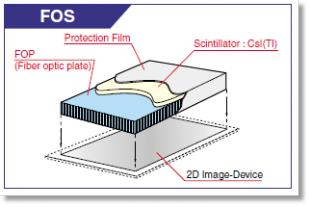

White traces are the signal created by the cosmic rays.
An interaction present in the image can be better highlighted in 3D representation (luminance on the Z axis) as below:
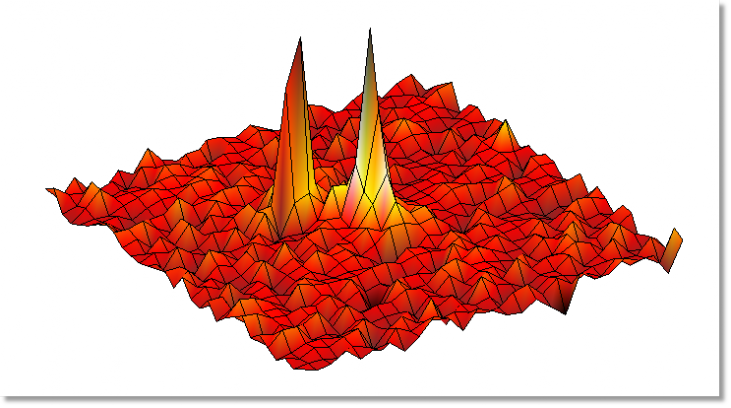
For the analysis of the images in search of events, I wrote a little program in javascript that executes the following operations for each image:
- Subtract an averaged dark from the row image
- The corrected image is analyzed in blocks of 10x10 pixel
- The standard deviation (STD) of the block under consideration is calculated
- If the STD exceeds the predetermined threshold, it calculates the centroid and the area of the event
- If the area of the event is greater than one pixel and there are not saturated pixels, it counts an event
- It moves to next block and return to point 3
Below you can see some strings generated by the program during the analysis:
Frame: 9, Event 15 @ X = 165.000, Y = 177.000, V = 266, A = 1
Frame: 9, Event 16 @ X = 440.000, Y = 206.718, V = 563, A = 2
Frame: 9, Event 17 @ X = 437.529, Y = 218.473, V = 217, A = 4
Frame: 9, Event 18 @ X = 439.000, Y = 223.000, V = 615, A = 1
Frame: 9, Event 19 @ X = 296.542, Y = 256.427, V = 252, A = 4
Frame: 9, Event 20 @ X = 352.000, Y = 284.000, V = 377, A = 1
Frame: 9, Event 21 @ X = 153.000, Y = 297.000, V = 690, A = 1
Eventually the script generates a text file with the counts recorded and displays the corresponding graph.
The image below highlights the areas of the chip that most have been involved as number of events (over 8 hours) and this is the demonstration that, over short periods of time, the bad luck exists!
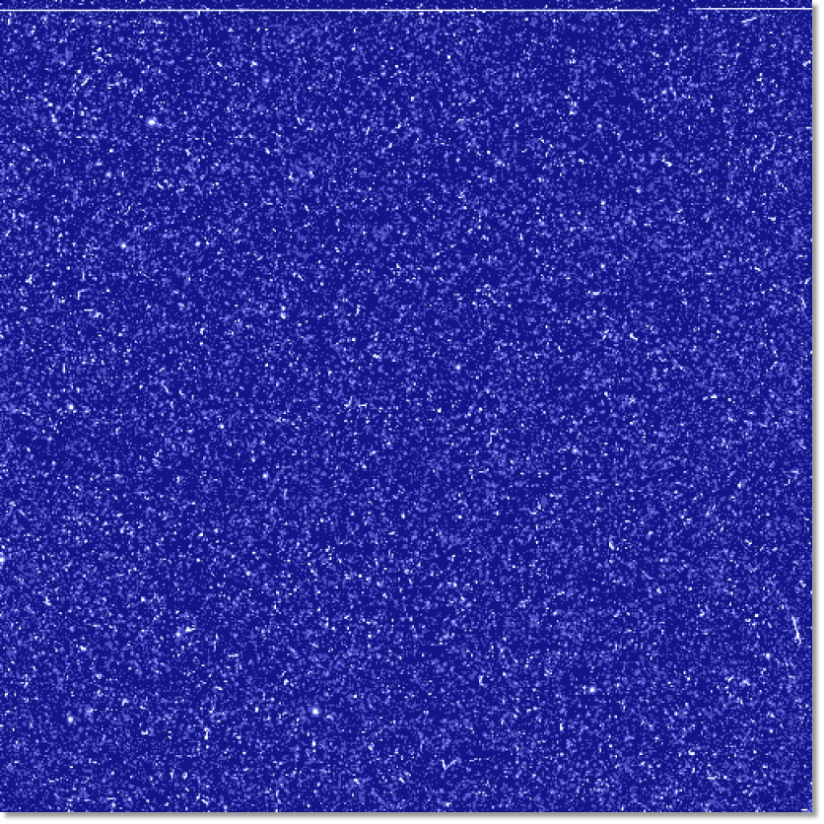
In conclusion, the introduction of CCD cameras at amateur astronomy has indeed brought a great capability to explore the space around us also to amateurs.
I honestly do not know how this technique of detection of cosmic rays is efficient compared to other types of technology, but certainly, if we already have a CCD camera we use for visible applications, we can easily use it even for this purpose without changing anything and who knows, maybe we can record the interaction with protons coming from a distant galaxy …
The measurements were made in August 2008.
Video: Cosmic ray rain
Riferimenti:
D. Pacini (1912). La radiazione penetrante alla superficie ed in seno alle acque . Il Nuovo Cimento Serie VI, Tomo 3: 93-100.
F. Hess (1912). Uber Beobachtungen der durchdringenden Strahlung bei sieben Freiballonfahrten . Physikalische Zeitschrift XIII: 1084-91
Bruna Bertucci, I raggi cosmici, Le Scienze n. 494 (ottobre 2009), pp. 64-71
R.G. Harrison and D.B. Stephenson, Detection of a galactic cosmic ray influence on clouds, Geophysical Research Abstracts, Vol. 8, 07661, 2006 SRef-ID: 1607-7962/gra/EGU06-A-07661
C. D. Anderson and S. H. Neddermeyer, Cloud Chamber Observations of Cosmic Rays at 4300 Meters Elevation and Near Sea-Level, Phys. Rev 50, 263,(1936).
M. Boezio et al., Measurement of the flux of atmospheric muons with the CAPRICE94 apparatus, Phys. Rev. D 62, 032007, (2000).
R. Clay and B. Dawson, Cosmic Bullets, Allen & Unwin, 1997. ISBN 1864482044
T. K. Gaisser, Cosmic Rays and Particle Physics, Cambridge University Press, 1990. ISBN 0521326672
P. K. F. Grieder, Cosmic Rays at Earth: Researcher’s Reference Manual and Data Book, Elsevier, 2001. ISBN 0444507108
A. M. Hillas, Cosmic Rays, Pergamon Press, Oxford, 1972 ISBN 0080167241
J. Kremer et al., Measurement of Ground-Level Muons at Two Geomagnetic Locations, Phys. Rev. Lett. 83, 4241, (1999).
S. H. Neddermeyer and C. D. Anderson, Note on the Nature of Cosmic-Ray Particles, Phys. Rev. 51, 844, (1937).
M. D. Ngobeni and M. S. Potgieter, Cosmic ray anisotropies in the outer heliosphere, Advances in Space Research, 2007.
M. D. Ngobeni, Aspects of the modulation of cosmic rays in the outer heliosphere, M.Sc Dissertation, Northwest University (Potchefstroom campus) South Africa 2006.
D. Perkins, Particle Astrophysics, Oxford University Press, 2003. ISBN 0198509510
C. E. Rolfs and S. R. William, Cauldrons in the Cosmos, The University of Chicago Press, 1988. ISBN 0226724565
B. B. Rossi, Cosmic Rays, McGraw-Hill, New York, 1964.
Martin Walt, Introduction to Geomagnetically Trapped Radiation, 1994. ISBN 0521431433
J. F. Ziegler, The Background In Detectors Caused By Sea Level Cosmic Rays, Nuclear Instruments and Methods 191, 419, (1981).
TRACER Long Duration Balloon Project: the largest cosmic ray detector launched on balloons.
Link:

